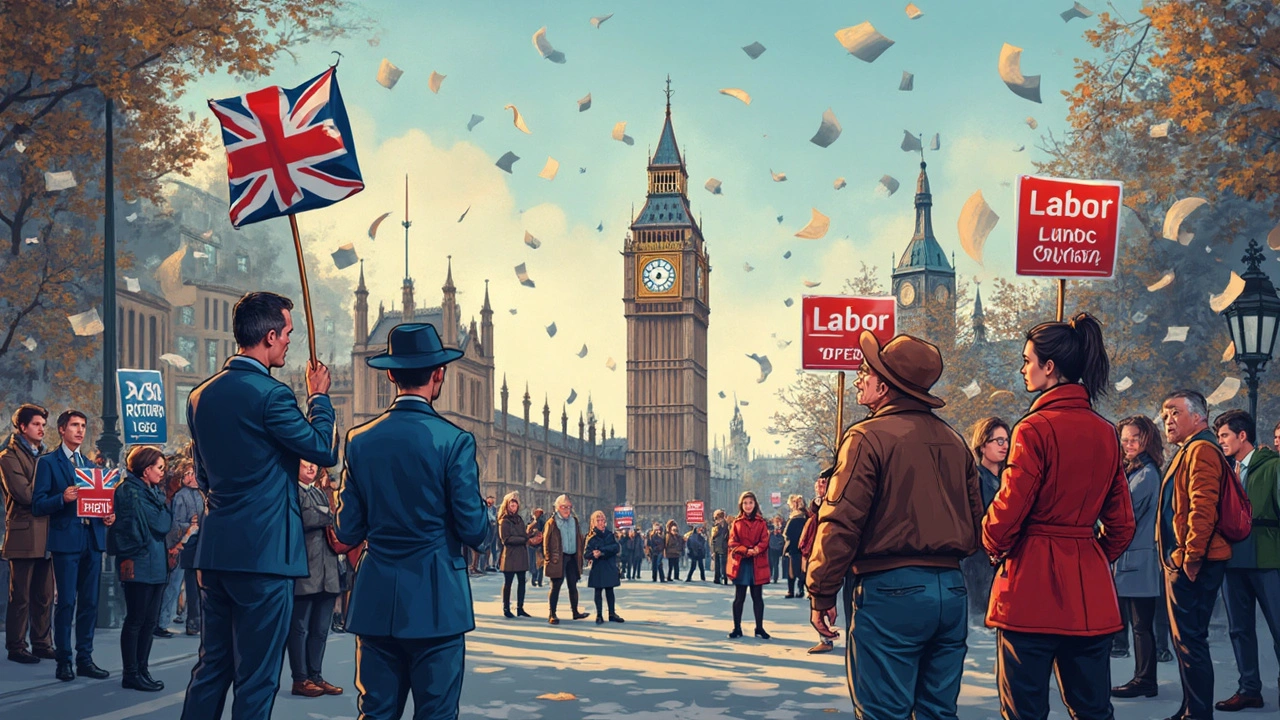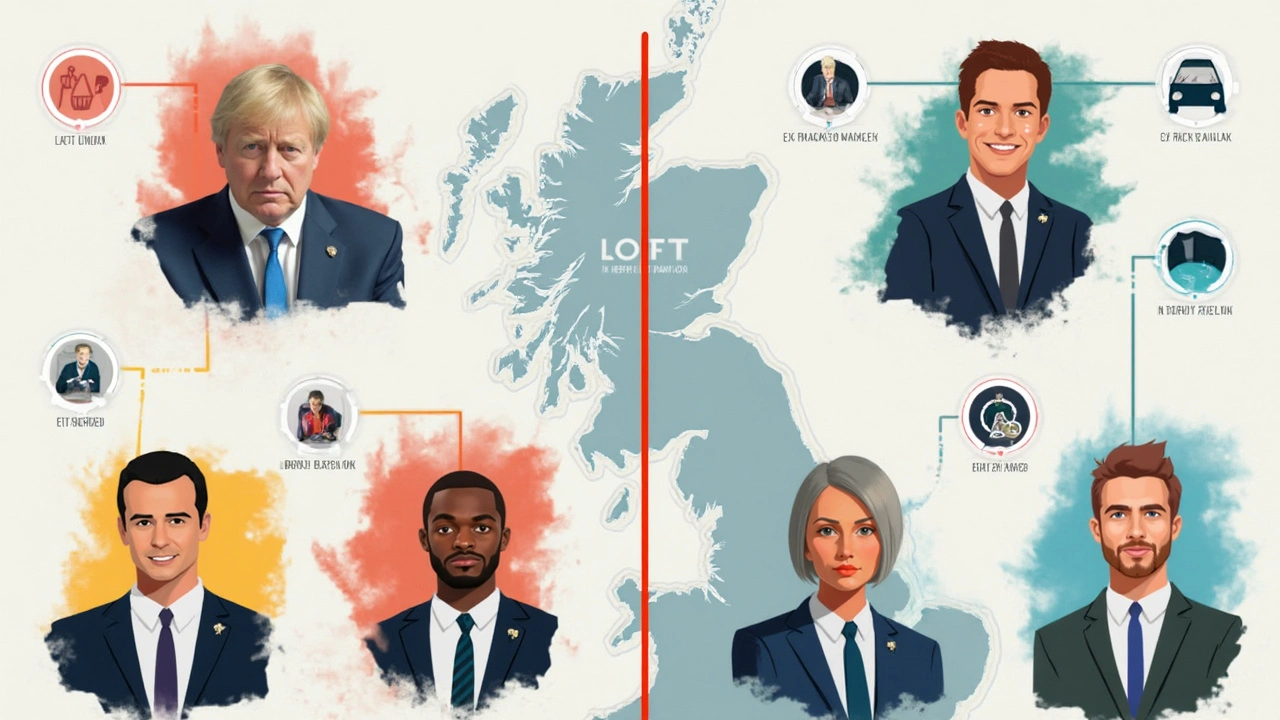
If you've ever tried to keep up with UK politics, you know it can sound like a jumble—Tories, Labour, Lib Dems, left wing, right wing. And then someone says 'the Conservatives are right-wing' and you’re left wondering, right of what? What does that actually mean?
The word 'Conservative' might look like it should mean “careful” or “traditional,” and in the UK, that's not far off. The Conservative Party is usually called 'right-wing.' They tend to support lower taxes, less government spending, and prefer things stay as they are over big changes. If you’re thinking in terms of the UK’s main parties, Conservatives stand clearly on the right, while Labour sits on the left.
Where this really gets interesting is in how it shapes things you see and hear every day—like the way taxes are handled, NHS funding, or school policies. These “left or right” labels actually end up deciding who pays what, which schools get money, or who qualifies for childcare. If you’re living in London, politics can even change things like how much you pay for transport, whether your local library is open, or the rules about renting a flat.
- Conservative Party: Left or Right?
- How UK Politics Defines Left and Right
- Comparing Conservatives to Other UK Parties
- Why This Matters for Everyday Life
Conservative Party: Left or Right?
The quick answer? The Conservative Party stands firmly on the right in the UK. When people talk about 'right-wing' in British politics, they're almost always talking about the Conservatives. These guys focus on things like keeping taxes lower, reducing government spending, stricter immigration rules, and supporting traditional values.
The Conservative Party’s roots go back almost 200 years. They were first called 'Tories,' supporting the monarchy and old-school ways. Over time, they've changed, but the basics are still there: keep change slow, support business, and look after individual freedoms rather than making everything public. Margaret Thatcher, who was Prime Minister in the 1980s, is probably the most famous Conservative. She cut taxes, sold off state-run companies, and promoted the idea that people should look after themselves before relying on the government. Even after her, leaders like David Cameron and Boris Johnson kept the party on the right, even if their styles were totally different.
Check out this snapshot to see how the party lines up on some big issues compared to Labour, their main rival:
| Policy Area | Conservatives (Right) | Labour (Left) |
|---|---|---|
| Taxes | Lower taxes | Higher taxes for wealthy |
| Welfare | Smaller, targeted | Wider, for all |
| Healthcare | Private options alongside NHS | More NHS funding |
| Immigration | Tighter controls | More open policies |
So if you ever hear someone in the UK talk about a 'right-wing government,' it’s almost always about the Conservatives. They're all about keeping markets open for business, keeping a close eye on the country’s borders, and holding back big government changes unless they really have to happen. It’s not always black and white, but if you look at how they vote and what they argue for, it’s clear they’re on the right.
How UK Politics Defines Left and Right
This whole "left and right" thing trips up a lot of people. In the UK, it’s pretty simple: right-wing means supporting less government control, lower taxes, and keeping traditions. Left-wing generally pushes for more public spending, more government support, and bigger changes to how society is run. It’s not just about money, though—it also gets down to views on things like immigration, the NHS, and climate policies.
Picture this: The Conservative Party likes the idea that people should have more say over their own money. That means lower income tax rates, fewer rules for businesses, and they’re usually wary about adding new welfare programs. They often talk about “personal responsibility” and keeping the economy strong by helping businesses.
On the flip side, Labour (the main left-wing party) will push for higher spending on things like hospitals, schools, and benefits. Their big argument is that government can help level the playing field. They’re more likely to talk about raising taxes on the rich, boosting workers’ rights, and improving public services for everyone.
If you want to spot whether a party sits left or right, check out their stances on things like:
- Taxes: Lower taxes lean right, higher taxes for public services lean left.
- Public Spending: Right-wing says cut spending, left-wing says invest more.
- Social Issues: Conservative views tend toward traditional; left-wing parties tend to support social change and rights.
- Privatisation: Right-wing likes private business running things, left-wing often wants services to stay public (think the NHS).
One helpful trick: party “manifestos” during elections are about as clear as it gets. Skim those and you’ll quickly see where each party stands on the big issues.

Comparing Conservatives to Other UK Parties
The quickest way to see where the Conservatives stand is by looking at other UK parties. Start with Labour, the main rival. Labour sits on the left, backing ideas like higher taxes for the rich, more NHS funding, and stronger workers’ rights. In 2019, they promised to bring back free university tuition and raise the minimum wage. That’s worlds apart from the Conservative approach of lower taxes and less government spending.
Then you’ve got the Liberal Democrats. They try to carve out a middle ground. On the economy, they’re often closer to Labour, but they’ve also joined coalitions with Conservatives, like in 2010. Lib Dems usually support social freedoms, rejoining the EU, and putting more cash into mental health services.
The Scottish National Party (SNP) runs most of Scotland. They’re left-leaning on things like public spending and the environment but are laser-focused on Scottish independence. Don’t get the SNP confused with the Conservatives; the two clash hard, especially over who should make the rules in Scotland.
There’s also Reform UK (formerly Brexit Party), which sits even further right than the Conservatives on lower immigration, pushing for strict UK borders, and less international cooperation. They’re not as big, but they draw voters who think Conservatives are too soft.
- The Greens: Well to the left, with a big focus on climate, social justice, and public ownership.
- Plaid Cymru: The Welsh party, like the SNP, is left-wing and big on local control.
So, when you stack them all together, Conservatives are on the right—less spending, stronger borders, private enterprise. That’s their territory, plain and simple. You probably won’t see them promising radical changes like Labour or championing independence like the SNP either.
Why This Matters for Everyday Life
Here’s where all those political debates suddenly hit home. The views of the Conservative Party, being right-wing, shape policies you bump into in daily life—sometimes when you’re not even thinking about politics at all.
For example, Conservatives usually push for lower income tax and try to keep public spending in check. Back in 2022, the party pushed for tax cuts, saying people should keep more of their earnings. If you’re a parent—like me, running after my son Silas—this might mean more money in your pocket, but also tighter budgets for places like schools and council-run youth services. If you use the NHS a lot, you might notice waiting lists going up when government spending is squeezed, since the Conservatives prefer less state involvement compared to Labour.
Housing’s another big one, especially in London. Conservative governments tend to be more pro-homeownership. Policies like “Help to Buy” were big headlines, aiming to get more people on the property ladder, but council house building hasn't kept pace with demand. That means renting stays expensive and social housing can be hard to come by. If you’re after a flat or struggling to pay rent, these party decisions shape what’s available and what you’ll pay.
Transport is one more thing most folks don’t connect with party politics, but maybe you should! Decisions about how much you pay for train travel, bus tickets, and even things like the ULEZ (Ultra Low Emission Zone) often come down to what party is in charge in Westminster or at City Hall. Conservative leaders usually argue for private investment in transport rather than raising taxes to fund new bus routes or cheaper fares.
Here’s a quick look at where party stances show up in everyday choices:
- Childcare and school funding: Cuts or investments depend on who’s in government.
- Healthcare access: NHS gets more support from left parties; Conservatives look for private partners.
- Job security and pay: Right-wing parties often want fewer worker protections, betting that it helps business.
- Benefits and support: Expect more strict eligibility and lower payouts under Conservative governments.
This stuff isn’t just about arguing on Twitter—it comes down to jobs, rents, school places, and even whether your local GP has a months-long wait. Understanding whether the Conservatives are left or right in the UK is really about knowing who’s likely to make those decisions, and what that means for your wallet, your commute, or your family’s future.